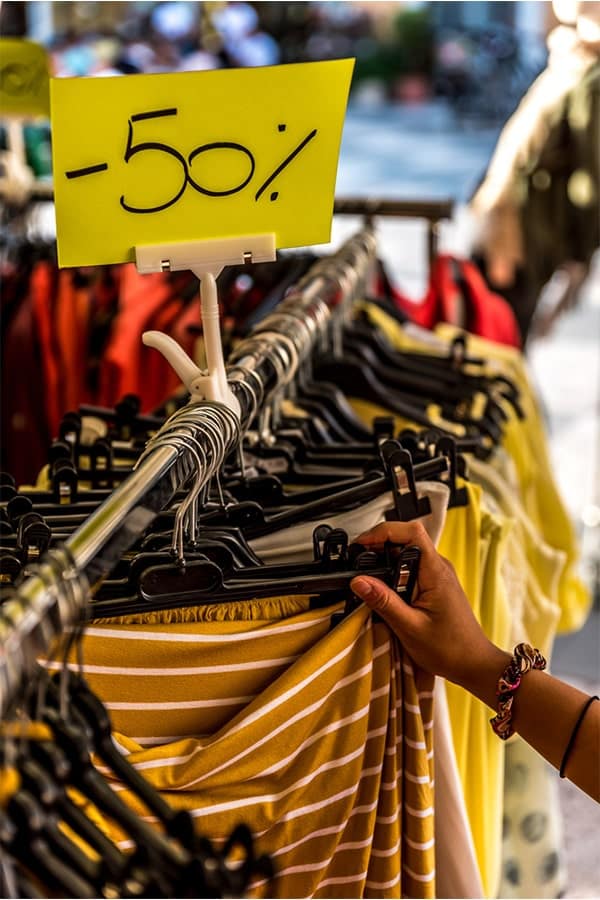Updated on August 28th, 2023
Fashion is one thing, but budget fashion is quite another. It’s both a skill and a lifestyle choice/necessity to live stylishly without dropping a ton of cash.
While I regularly talk trends and show off “budget fashion” picks, it’s been awhile since I’ve taken a step back and delved into the broader shopping strategies of a budget fashionista.
A true budget fashionista is strategic about the pieces she wears. She’s confident and put together. She’s meticulous about budgeting for clothes. She doesn’t dress for comments or compliments — she dresses for herself. And she does it without a closet full of labels, a heavy reliance on sequins, or an addition to trends.
Sound like you? Awesome. So, here goes: 18 budget shopping hacks to stay stylish and solvent.
1. Shop with cash or a dedicated card

Many moons ago, I used to say: shop only with cash. It’s the best way to ensure you don’t overspend. But these days, I don’t like telling you to head out with a wad of cash in your purse.
A close alternative is to dedicate one reloadable Visa gift card to your clothing purchases. Whatever your monthly clothing budget is, that’s what you load on the card monthly. When the money runs out, you stop shopping.
You can also use a dedicated credit card. Set up your bill pay to send your monthly budget amount to the card each month. If you overspend, you’ll eventually see your budget eaten away by interest charges.
2. Consider cost per wear
Value is the key when building a great closet. The cost per wear formula can help you get the most bang for your buck. Cost per wear is the price of an item divided by the number of times you wear it.
So if an item costs $100, and you wear it 10 times, the cost per wear is $10. The more you wear an item, the lower your cost per wear.
Obviously, you don’t know exactly how many times you’ll wear a piece before you buy it. The idea here is to think through that question. Consider the utility of an item rather than the price. It’s never a bargain to buy $5 top you never wear. You’re better off spending $30 on a top you wear all the time.
3. Know what looks good on you
I’ve covered this topic before. Knowing the silhouettes that flatter your shape makes for a more enjoyable and reliable shopping experience — particularly when you’re shopping online. Try these resources to help:
- How to dress for your boy shaped body
- Dressing for your body type — top 3 tips
- Dresses for those big on top and small on bottom
4. Chat up the sales associates
Sales associates should be your best friends in the store. They know best how to save in that store. Ask about discounts, upcoming sales and loyalty programs — often you can get them to scan a coupon you don’t have or ring you up in multiple transactions so you can use more than one coupon.
If you’re shopping online, consider using the chat or personal shopper services. Sometimes you can score discounts this way. At a minimum, you’ll get help finding some options you may not have surfaced yourself.
5. Join the loyalty program
If a store’s loyalty program is free, join it. You’ll often get birthday or holiday discounts, plus early access to sales.
6. Try on aggressively and buy conservatively
I can’t tell you how many times I have tried on pieces that I wasn’t sure about, only to end up loving them and taking them home. Don’t be too particular about what you try on, especially if you’re digging through clearance racks.

You should be particular about what you end up buying though. Some questions to ask before you take it to the register:
- Can I wear this with pieces I already have at home? Don’t buy something that requires you to spend another $100 to complete the look.
- How often will I wear this? (The essential cost per wear question!)
- Will I feel silly wearing this next year or next season? (Ultra trendy pieces can be fun, but also short-lived.)
7. Find a good tailor
Garments that don’t fit well often end up on the clearance rack or the thrift store. But a little nip and tuck can take that piece from frumpy to fabulous. Just remember to consider the cost of the tailor when you’re thinking about cost per wear.
8. Remember the 70/30 rule
Fashionistas with limited budgets should follow the 70/30 rule: 70% of your closet should be classic pieces, 30% trendy pieces. Go as cheap as possible on trendy items because they have a short closet lifespan. Try these stores:
Go designer on classic pieces like black suits (Tahari, Donna Karan), coats (Burberry, MaxMara), evening wear (Armani, Tim and Linda Platt, Carmen Marc Valvo), and purses (Coach, Longchamp, Marc Jacobs).
9. Try in store, buy online
Just this week, I purchased a long, cream-colored, v-neck sweater, which is a fabulous, versatile addition to my winter rotation. After I checked out, my fellow fashionista Hillary tells me she bought the same sweater at Century 21 for $10 less. And $10 is $10, right?
Lesson learned: when you find a piece you like, take a few minutes to search online for a lower price.
10. Swap clothes with friends
I get the shopping bug mostly when I’m bored with my options. Delay that next big shopping trip by trading clothes with friends. Gather up the stuff you don’t wear much anymore and ask your friends to do the same. Pick up a few bottles of wine, get everyone together, and start trading!
11. Shop slowly

Never go shopping when you’re in a hurry. If you’ve done this before, you know the outcome. You grab something off the rack that later turns out to be too small or too big or too expensive or too bold or too timid.
Budget shopping takes time, because you’re not looking for the cheapest thing or the biggest discount. You’re looking for quality pieces you love so much you’ll wear them all the time. Oh, and the price has to be right. This is no small venture. Give yourself time and enjoy the shopping journey.
12. Time it right
July/August and late January/February are the best times to hit the stores for deals. Write down the names of your favorite stores, go online, and register to receive coupons, special invitations, and notifications of new products.
Outlet stores are also great sources of designer goods.
13. Make a shopping list
When shopping for yourself (or for gifts), write a detailed shopping list. When buying gifts, include all the people you need to shop for, gift ideas, and your max budget for each person.
Keep the list out while you’re shopping, and have a pen handy to jot notes and check off items as you shop.
14. Get double-duty pieces
Not every item you wear to work, to a meeting, or to an interview needs to be a traditional suit. The exception is if you work in law or finance, in which case you may need to stick to the basics. A tailored sheath dress paired with a cardigan and tights can make a flawless outfit for the office.
And, that same dress will look hot sans cardi for a night out. Focus on finding fashion that can work in multiple situations.
15. Never pay full price

There is one golden rule in mall-based retail — everything goes on sale (I’m looking at you, Macy’s). 🙂 It usually takes six to eight weeks between when an item gets put on the floor and when it gets discounted. Wait it out and save.
16. Know your wardrobe
Take inventory of what’s already in your closet. You may be surprised by what you find. More importantly, you won’t make the mistake of buying the same item again.
If you have three striped blouses, do you really need another? Probably not. And if you know that, you won’t be spending cash where it need not be spent.
17. Don’t be fooled by the sales sign
Just because something is on sale, doesn’t mean it’s a bargain. Before purchasing, ask yourself “Can I think of at least three places I’ll wear this?” If the answer is no, move on.
18. Return unwanted items ASAP
Receipts have a tendency to get lost. Returning your items as quickly as possible reduces this risk AND makes sure you return it before the deadline.
Budget shopping is value shopping
At the end of the day, budget shopping is value shopping. Buy versatile, classically styled pieces you’ll wear often. When you’re itching to jump in on the season’s fashion trends, do that with low-cost accessories and sale items. That’s how you spend less on clothes overall.